University CPI Project: Reducing CLABSI Incidence in Healthcare
VerifiedAdded on 2021/11/12
|12
|3679
|26
Project
AI Summary
This CPI project report focuses on reducing the incidence of central line associated bloodstream infections (CLABSI) in a healthcare unit. The project aims to reduce CLABSI rates by 50% within six months through a PDSA (Plan-Do-Study-Act) cycle-based intervention. The project addresses the relevance of clinical governance, highlighting its alignment with the seven pillars, particularly clinical effectiveness and risk management. The report emphasizes the significance of the issue, citing evidence of CLABSI's adverse effects, mortality rates, and financial impact. Key stakeholders include nurses, pharmacists, medical officers, and the patient voice. The intervention involves staff education on infection control, specifically the use of chlorhexidine gluconate washcloths, aiming to enhance staff knowledge and improve practice. The project's progress will be evaluated through CLABSI rate assessments, stakeholder involvement, and adherence to clinical governance principles. The report details the implementation plan, including staff education sessions, outcome measurements, and evaluation methods, to ensure the project's effectiveness and sustainability.

Running head: CPI PROJECT ON CLABSI
CPI project on CLABSI
Name of the student:
Name of the university:
Author note:
CPI project on CLABSI
Name of the student:
Name of the university:
Author note:
Paraphrase This Document
Need a fresh take? Get an instant paraphrase of this document with our AI Paraphraser
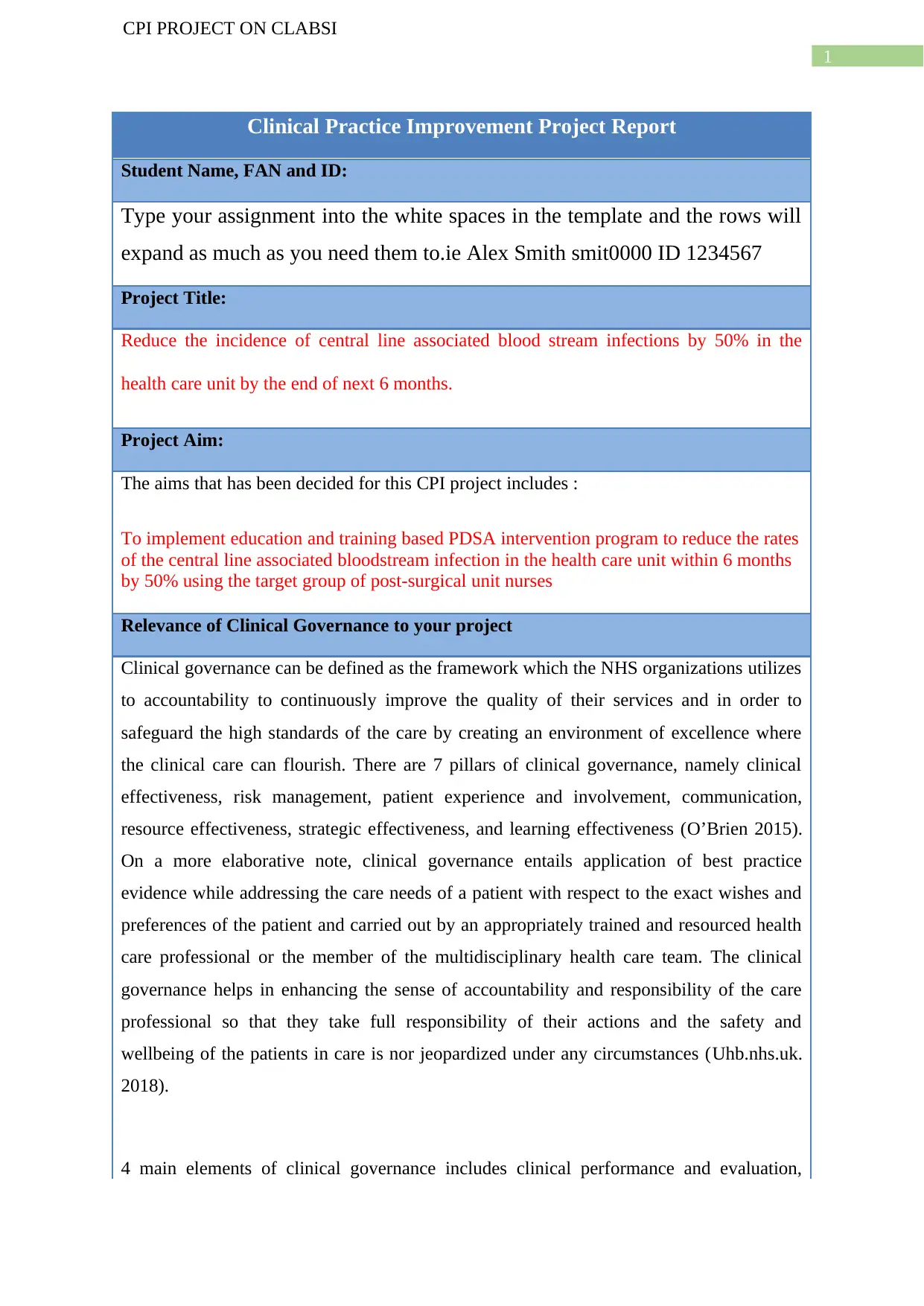
1
CPI PROJECT ON CLABSI
Clinical Practice Improvement Project Report
Student Name, FAN and ID:
Type your assignment into the white spaces in the template and the rows will
expand as much as you need them to.ie Alex Smith smit0000 ID 1234567
Project Title:
Reduce the incidence of central line associated blood stream infections by 50% in the
health care unit by the end of next 6 months.
Project Aim:
The aims that has been decided for this CPI project includes :
To implement education and training based PDSA intervention program to reduce the rates
of the central line associated bloodstream infection in the health care unit within 6 months
by 50% using the target group of post-surgical unit nurses
Relevance of Clinical Governance to your project
Clinical governance can be defined as the framework which the NHS organizations utilizes
to accountability to continuously improve the quality of their services and in order to
safeguard the high standards of the care by creating an environment of excellence where
the clinical care can flourish. There are 7 pillars of clinical governance, namely clinical
effectiveness, risk management, patient experience and involvement, communication,
resource effectiveness, strategic effectiveness, and learning effectiveness (O’Brien 2015).
On a more elaborative note, clinical governance entails application of best practice
evidence while addressing the care needs of a patient with respect to the exact wishes and
preferences of the patient and carried out by an appropriately trained and resourced health
care professional or the member of the multidisciplinary health care team. The clinical
governance helps in enhancing the sense of accountability and responsibility of the care
professional so that they take full responsibility of their actions and the safety and
wellbeing of the patients in care is nor jeopardized under any circumstances (Uhb.nhs.uk.
2018).
4 main elements of clinical governance includes clinical performance and evaluation,
CPI PROJECT ON CLABSI
Clinical Practice Improvement Project Report
Student Name, FAN and ID:
Type your assignment into the white spaces in the template and the rows will
expand as much as you need them to.ie Alex Smith smit0000 ID 1234567
Project Title:
Reduce the incidence of central line associated blood stream infections by 50% in the
health care unit by the end of next 6 months.
Project Aim:
The aims that has been decided for this CPI project includes :
To implement education and training based PDSA intervention program to reduce the rates
of the central line associated bloodstream infection in the health care unit within 6 months
by 50% using the target group of post-surgical unit nurses
Relevance of Clinical Governance to your project
Clinical governance can be defined as the framework which the NHS organizations utilizes
to accountability to continuously improve the quality of their services and in order to
safeguard the high standards of the care by creating an environment of excellence where
the clinical care can flourish. There are 7 pillars of clinical governance, namely clinical
effectiveness, risk management, patient experience and involvement, communication,
resource effectiveness, strategic effectiveness, and learning effectiveness (O’Brien 2015).
On a more elaborative note, clinical governance entails application of best practice
evidence while addressing the care needs of a patient with respect to the exact wishes and
preferences of the patient and carried out by an appropriately trained and resourced health
care professional or the member of the multidisciplinary health care team. The clinical
governance helps in enhancing the sense of accountability and responsibility of the care
professional so that they take full responsibility of their actions and the safety and
wellbeing of the patients in care is nor jeopardized under any circumstances (Uhb.nhs.uk.
2018).
4 main elements of clinical governance includes clinical performance and evaluation,
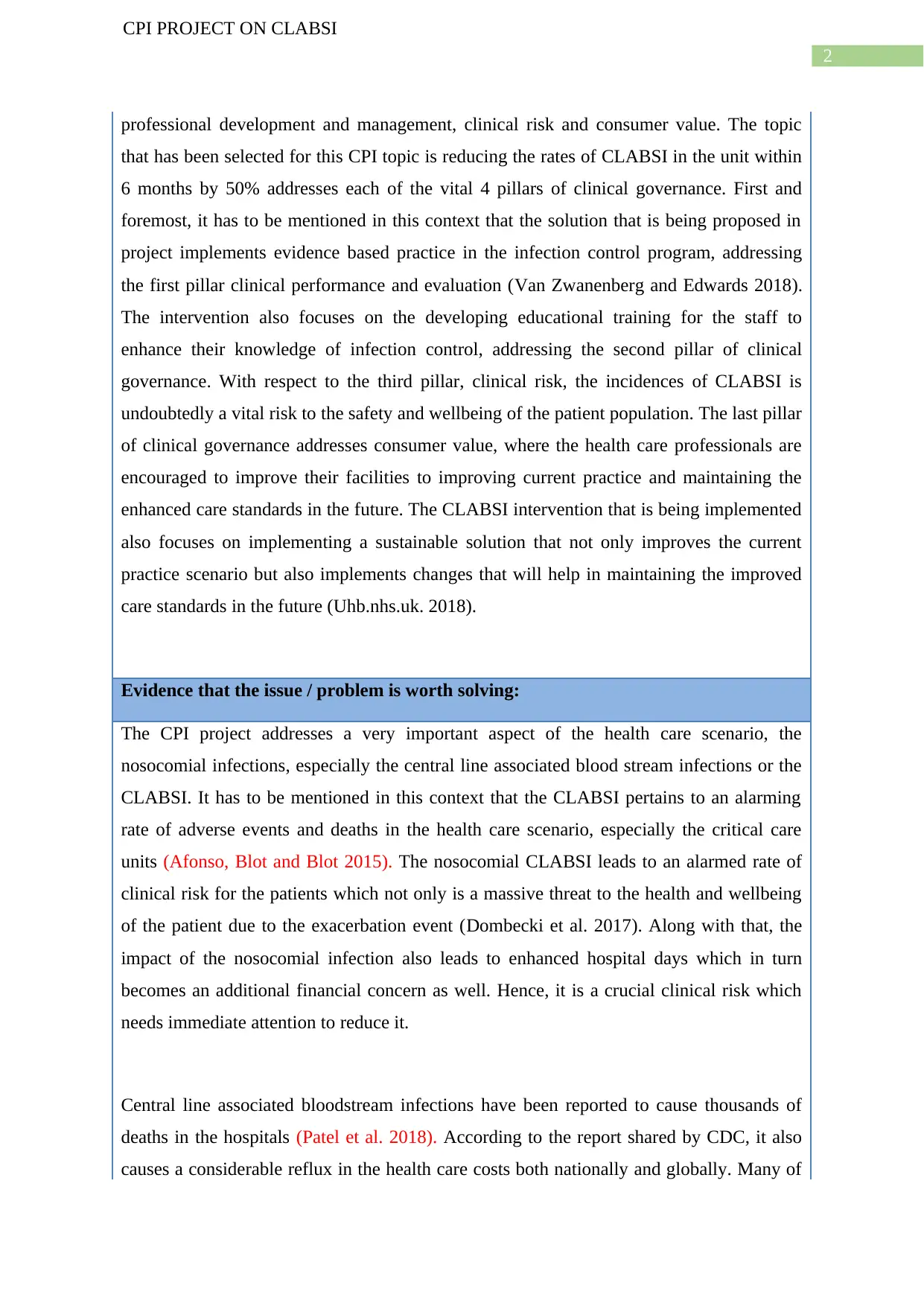
2
CPI PROJECT ON CLABSI
professional development and management, clinical risk and consumer value. The topic
that has been selected for this CPI topic is reducing the rates of CLABSI in the unit within
6 months by 50% addresses each of the vital 4 pillars of clinical governance. First and
foremost, it has to be mentioned in this context that the solution that is being proposed in
project implements evidence based practice in the infection control program, addressing
the first pillar clinical performance and evaluation (Van Zwanenberg and Edwards 2018).
The intervention also focuses on the developing educational training for the staff to
enhance their knowledge of infection control, addressing the second pillar of clinical
governance. With respect to the third pillar, clinical risk, the incidences of CLABSI is
undoubtedly a vital risk to the safety and wellbeing of the patient population. The last pillar
of clinical governance addresses consumer value, where the health care professionals are
encouraged to improve their facilities to improving current practice and maintaining the
enhanced care standards in the future. The CLABSI intervention that is being implemented
also focuses on implementing a sustainable solution that not only improves the current
practice scenario but also implements changes that will help in maintaining the improved
care standards in the future (Uhb.nhs.uk. 2018).
Evidence that the issue / problem is worth solving:
The CPI project addresses a very important aspect of the health care scenario, the
nosocomial infections, especially the central line associated blood stream infections or the
CLABSI. It has to be mentioned in this context that the CLABSI pertains to an alarming
rate of adverse events and deaths in the health care scenario, especially the critical care
units (Afonso, Blot and Blot 2015). The nosocomial CLABSI leads to an alarmed rate of
clinical risk for the patients which not only is a massive threat to the health and wellbeing
of the patient due to the exacerbation event (Dombecki et al. 2017). Along with that, the
impact of the nosocomial infection also leads to enhanced hospital days which in turn
becomes an additional financial concern as well. Hence, it is a crucial clinical risk which
needs immediate attention to reduce it.
Central line associated bloodstream infections have been reported to cause thousands of
deaths in the hospitals (Patel et al. 2018). According to the report shared by CDC, it also
causes a considerable reflux in the health care costs both nationally and globally. Many of
CPI PROJECT ON CLABSI
professional development and management, clinical risk and consumer value. The topic
that has been selected for this CPI topic is reducing the rates of CLABSI in the unit within
6 months by 50% addresses each of the vital 4 pillars of clinical governance. First and
foremost, it has to be mentioned in this context that the solution that is being proposed in
project implements evidence based practice in the infection control program, addressing
the first pillar clinical performance and evaluation (Van Zwanenberg and Edwards 2018).
The intervention also focuses on the developing educational training for the staff to
enhance their knowledge of infection control, addressing the second pillar of clinical
governance. With respect to the third pillar, clinical risk, the incidences of CLABSI is
undoubtedly a vital risk to the safety and wellbeing of the patient population. The last pillar
of clinical governance addresses consumer value, where the health care professionals are
encouraged to improve their facilities to improving current practice and maintaining the
enhanced care standards in the future. The CLABSI intervention that is being implemented
also focuses on implementing a sustainable solution that not only improves the current
practice scenario but also implements changes that will help in maintaining the improved
care standards in the future (Uhb.nhs.uk. 2018).
Evidence that the issue / problem is worth solving:
The CPI project addresses a very important aspect of the health care scenario, the
nosocomial infections, especially the central line associated blood stream infections or the
CLABSI. It has to be mentioned in this context that the CLABSI pertains to an alarming
rate of adverse events and deaths in the health care scenario, especially the critical care
units (Afonso, Blot and Blot 2015). The nosocomial CLABSI leads to an alarmed rate of
clinical risk for the patients which not only is a massive threat to the health and wellbeing
of the patient due to the exacerbation event (Dombecki et al. 2017). Along with that, the
impact of the nosocomial infection also leads to enhanced hospital days which in turn
becomes an additional financial concern as well. Hence, it is a crucial clinical risk which
needs immediate attention to reduce it.
Central line associated bloodstream infections have been reported to cause thousands of
deaths in the hospitals (Patel et al. 2018). According to the report shared by CDC, it also
causes a considerable reflux in the health care costs both nationally and globally. Many of
⊘ This is a preview!⊘
Do you want full access?
Subscribe today to unlock all pages.

Trusted by 1+ million students worldwide
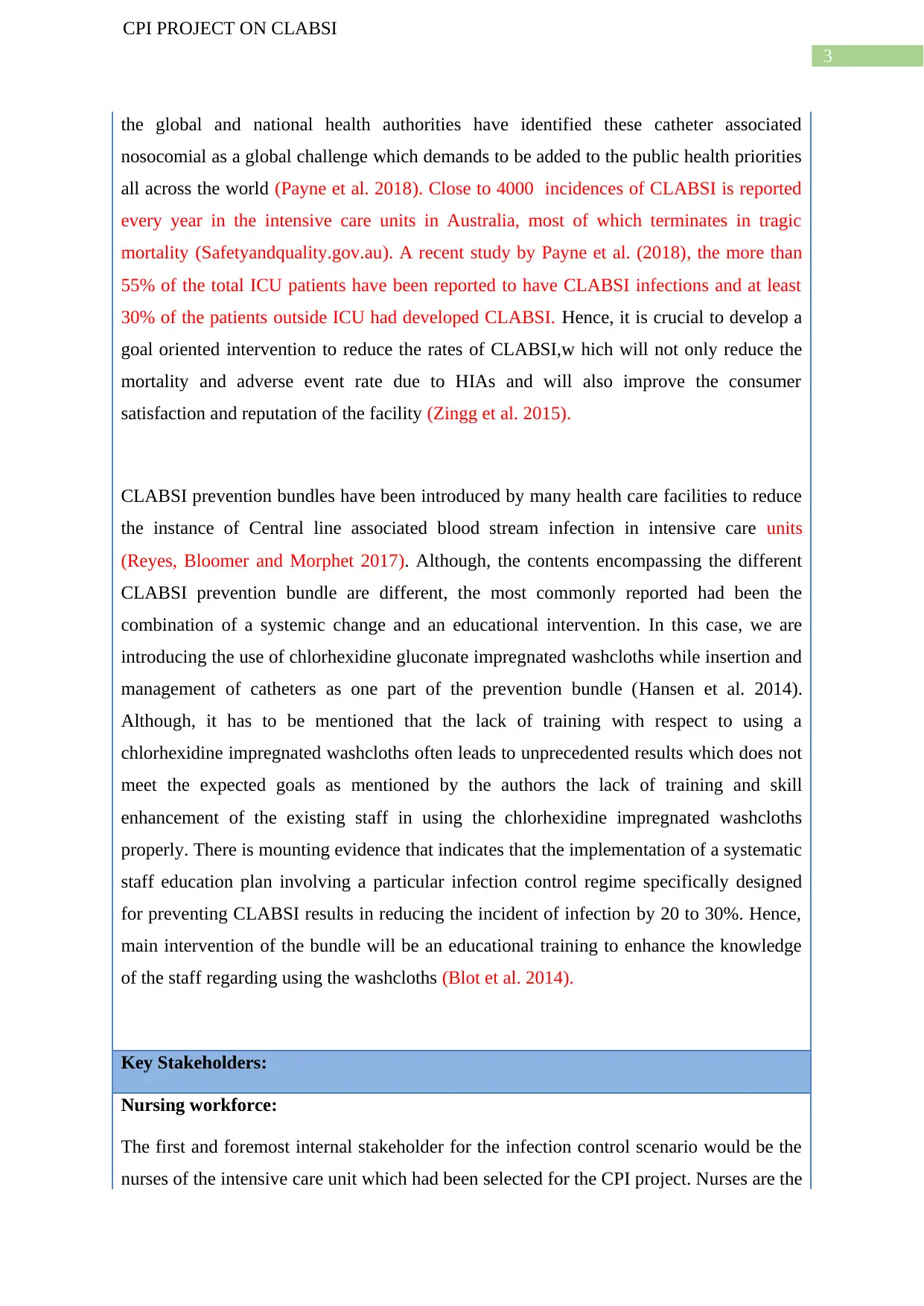
3
CPI PROJECT ON CLABSI
the global and national health authorities have identified these catheter associated
nosocomial as a global challenge which demands to be added to the public health priorities
all across the world (Payne et al. 2018). Close to 4000 incidences of CLABSI is reported
every year in the intensive care units in Australia, most of which terminates in tragic
mortality (Safetyandquality.gov.au). A recent study by Payne et al. (2018), the more than
55% of the total ICU patients have been reported to have CLABSI infections and at least
30% of the patients outside ICU had developed CLABSI. Hence, it is crucial to develop a
goal oriented intervention to reduce the rates of CLABSI,w hich will not only reduce the
mortality and adverse event rate due to HIAs and will also improve the consumer
satisfaction and reputation of the facility (Zingg et al. 2015).
CLABSI prevention bundles have been introduced by many health care facilities to reduce
the instance of Central line associated blood stream infection in intensive care units
(Reyes, Bloomer and Morphet 2017). Although, the contents encompassing the different
CLABSI prevention bundle are different, the most commonly reported had been the
combination of a systemic change and an educational intervention. In this case, we are
introducing the use of chlorhexidine gluconate impregnated washcloths while insertion and
management of catheters as one part of the prevention bundle (Hansen et al. 2014).
Although, it has to be mentioned that the lack of training with respect to using a
chlorhexidine impregnated washcloths often leads to unprecedented results which does not
meet the expected goals as mentioned by the authors the lack of training and skill
enhancement of the existing staff in using the chlorhexidine impregnated washcloths
properly. There is mounting evidence that indicates that the implementation of a systematic
staff education plan involving a particular infection control regime specifically designed
for preventing CLABSI results in reducing the incident of infection by 20 to 30%. Hence,
main intervention of the bundle will be an educational training to enhance the knowledge
of the staff regarding using the washcloths (Blot et al. 2014).
Key Stakeholders:
Nursing workforce:
The first and foremost internal stakeholder for the infection control scenario would be the
nurses of the intensive care unit which had been selected for the CPI project. Nurses are the
CPI PROJECT ON CLABSI
the global and national health authorities have identified these catheter associated
nosocomial as a global challenge which demands to be added to the public health priorities
all across the world (Payne et al. 2018). Close to 4000 incidences of CLABSI is reported
every year in the intensive care units in Australia, most of which terminates in tragic
mortality (Safetyandquality.gov.au). A recent study by Payne et al. (2018), the more than
55% of the total ICU patients have been reported to have CLABSI infections and at least
30% of the patients outside ICU had developed CLABSI. Hence, it is crucial to develop a
goal oriented intervention to reduce the rates of CLABSI,w hich will not only reduce the
mortality and adverse event rate due to HIAs and will also improve the consumer
satisfaction and reputation of the facility (Zingg et al. 2015).
CLABSI prevention bundles have been introduced by many health care facilities to reduce
the instance of Central line associated blood stream infection in intensive care units
(Reyes, Bloomer and Morphet 2017). Although, the contents encompassing the different
CLABSI prevention bundle are different, the most commonly reported had been the
combination of a systemic change and an educational intervention. In this case, we are
introducing the use of chlorhexidine gluconate impregnated washcloths while insertion and
management of catheters as one part of the prevention bundle (Hansen et al. 2014).
Although, it has to be mentioned that the lack of training with respect to using a
chlorhexidine impregnated washcloths often leads to unprecedented results which does not
meet the expected goals as mentioned by the authors the lack of training and skill
enhancement of the existing staff in using the chlorhexidine impregnated washcloths
properly. There is mounting evidence that indicates that the implementation of a systematic
staff education plan involving a particular infection control regime specifically designed
for preventing CLABSI results in reducing the incident of infection by 20 to 30%. Hence,
main intervention of the bundle will be an educational training to enhance the knowledge
of the staff regarding using the washcloths (Blot et al. 2014).
Key Stakeholders:
Nursing workforce:
The first and foremost internal stakeholder for the infection control scenario would be the
nurses of the intensive care unit which had been selected for the CPI project. Nurses are the
Paraphrase This Document
Need a fresh take? Get an instant paraphrase of this document with our AI Paraphraser
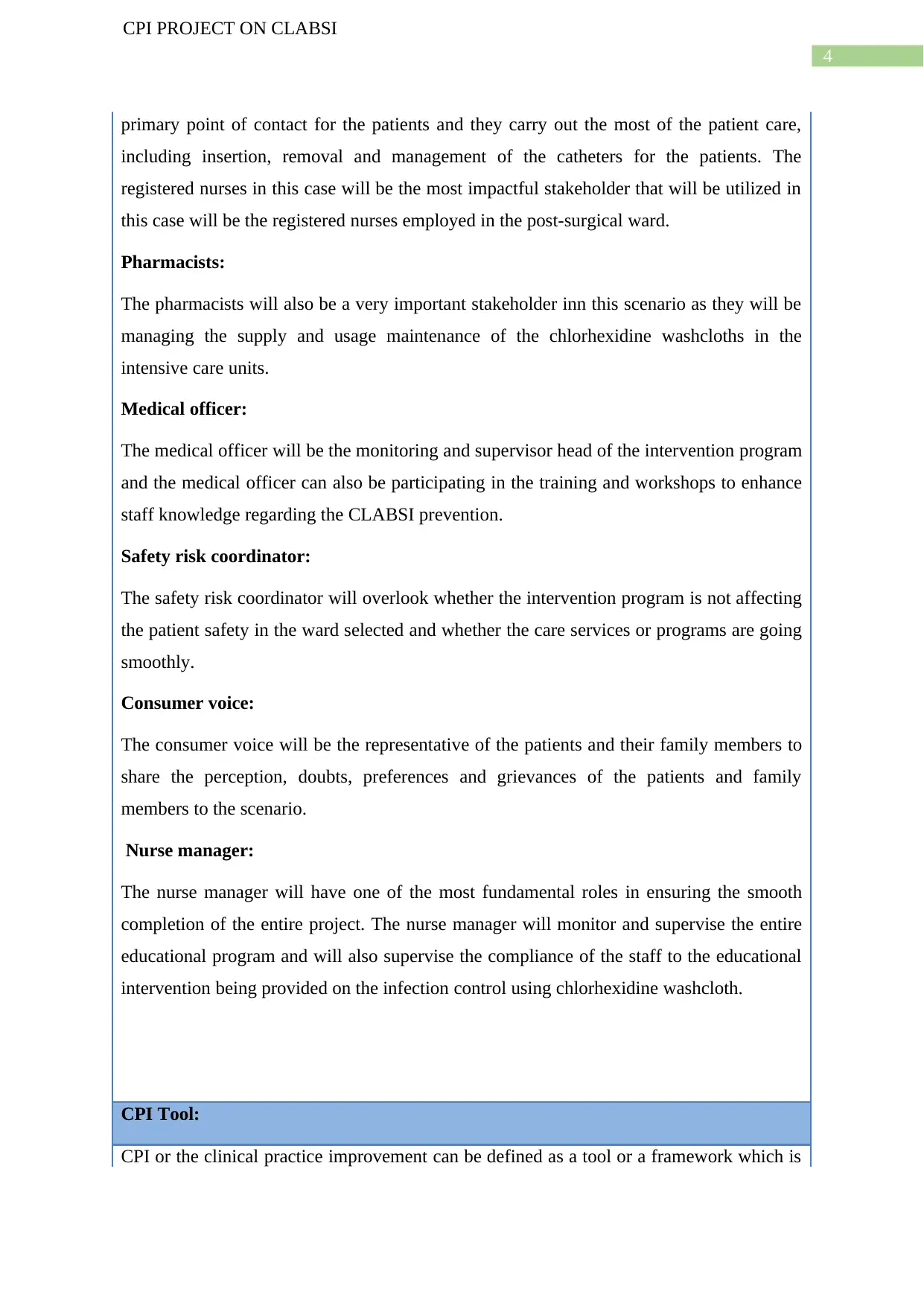
4
CPI PROJECT ON CLABSI
primary point of contact for the patients and they carry out the most of the patient care,
including insertion, removal and management of the catheters for the patients. The
registered nurses in this case will be the most impactful stakeholder that will be utilized in
this case will be the registered nurses employed in the post-surgical ward.
Pharmacists:
The pharmacists will also be a very important stakeholder inn this scenario as they will be
managing the supply and usage maintenance of the chlorhexidine washcloths in the
intensive care units.
Medical officer:
The medical officer will be the monitoring and supervisor head of the intervention program
and the medical officer can also be participating in the training and workshops to enhance
staff knowledge regarding the CLABSI prevention.
Safety risk coordinator:
The safety risk coordinator will overlook whether the intervention program is not affecting
the patient safety in the ward selected and whether the care services or programs are going
smoothly.
Consumer voice:
The consumer voice will be the representative of the patients and their family members to
share the perception, doubts, preferences and grievances of the patients and family
members to the scenario.
Nurse manager:
The nurse manager will have one of the most fundamental roles in ensuring the smooth
completion of the entire project. The nurse manager will monitor and supervise the entire
educational program and will also supervise the compliance of the staff to the educational
intervention being provided on the infection control using chlorhexidine washcloth.
CPI Tool:
CPI or the clinical practice improvement can be defined as a tool or a framework which is
CPI PROJECT ON CLABSI
primary point of contact for the patients and they carry out the most of the patient care,
including insertion, removal and management of the catheters for the patients. The
registered nurses in this case will be the most impactful stakeholder that will be utilized in
this case will be the registered nurses employed in the post-surgical ward.
Pharmacists:
The pharmacists will also be a very important stakeholder inn this scenario as they will be
managing the supply and usage maintenance of the chlorhexidine washcloths in the
intensive care units.
Medical officer:
The medical officer will be the monitoring and supervisor head of the intervention program
and the medical officer can also be participating in the training and workshops to enhance
staff knowledge regarding the CLABSI prevention.
Safety risk coordinator:
The safety risk coordinator will overlook whether the intervention program is not affecting
the patient safety in the ward selected and whether the care services or programs are going
smoothly.
Consumer voice:
The consumer voice will be the representative of the patients and their family members to
share the perception, doubts, preferences and grievances of the patients and family
members to the scenario.
Nurse manager:
The nurse manager will have one of the most fundamental roles in ensuring the smooth
completion of the entire project. The nurse manager will monitor and supervise the entire
educational program and will also supervise the compliance of the staff to the educational
intervention being provided on the infection control using chlorhexidine washcloth.
CPI Tool:
CPI or the clinical practice improvement can be defined as a tool or a framework which is
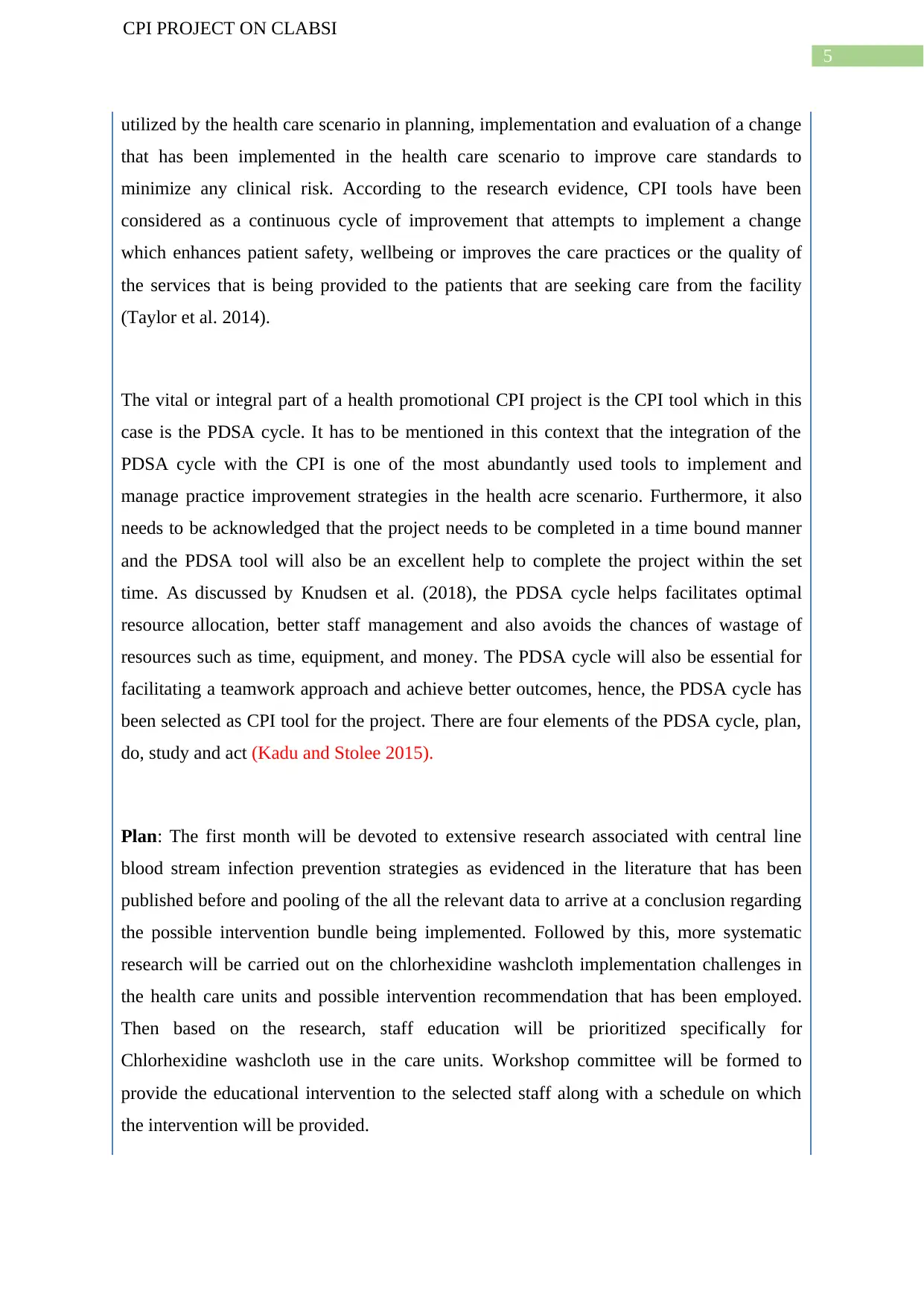
5
CPI PROJECT ON CLABSI
utilized by the health care scenario in planning, implementation and evaluation of a change
that has been implemented in the health care scenario to improve care standards to
minimize any clinical risk. According to the research evidence, CPI tools have been
considered as a continuous cycle of improvement that attempts to implement a change
which enhances patient safety, wellbeing or improves the care practices or the quality of
the services that is being provided to the patients that are seeking care from the facility
(Taylor et al. 2014).
The vital or integral part of a health promotional CPI project is the CPI tool which in this
case is the PDSA cycle. It has to be mentioned in this context that the integration of the
PDSA cycle with the CPI is one of the most abundantly used tools to implement and
manage practice improvement strategies in the health acre scenario. Furthermore, it also
needs to be acknowledged that the project needs to be completed in a time bound manner
and the PDSA tool will also be an excellent help to complete the project within the set
time. As discussed by Knudsen et al. (2018), the PDSA cycle helps facilitates optimal
resource allocation, better staff management and also avoids the chances of wastage of
resources such as time, equipment, and money. The PDSA cycle will also be essential for
facilitating a teamwork approach and achieve better outcomes, hence, the PDSA cycle has
been selected as CPI tool for the project. There are four elements of the PDSA cycle, plan,
do, study and act (Kadu and Stolee 2015).
Plan: The first month will be devoted to extensive research associated with central line
blood stream infection prevention strategies as evidenced in the literature that has been
published before and pooling of the all the relevant data to arrive at a conclusion regarding
the possible intervention bundle being implemented. Followed by this, more systematic
research will be carried out on the chlorhexidine washcloth implementation challenges in
the health care units and possible intervention recommendation that has been employed.
Then based on the research, staff education will be prioritized specifically for
Chlorhexidine washcloth use in the care units. Workshop committee will be formed to
provide the educational intervention to the selected staff along with a schedule on which
the intervention will be provided.
CPI PROJECT ON CLABSI
utilized by the health care scenario in planning, implementation and evaluation of a change
that has been implemented in the health care scenario to improve care standards to
minimize any clinical risk. According to the research evidence, CPI tools have been
considered as a continuous cycle of improvement that attempts to implement a change
which enhances patient safety, wellbeing or improves the care practices or the quality of
the services that is being provided to the patients that are seeking care from the facility
(Taylor et al. 2014).
The vital or integral part of a health promotional CPI project is the CPI tool which in this
case is the PDSA cycle. It has to be mentioned in this context that the integration of the
PDSA cycle with the CPI is one of the most abundantly used tools to implement and
manage practice improvement strategies in the health acre scenario. Furthermore, it also
needs to be acknowledged that the project needs to be completed in a time bound manner
and the PDSA tool will also be an excellent help to complete the project within the set
time. As discussed by Knudsen et al. (2018), the PDSA cycle helps facilitates optimal
resource allocation, better staff management and also avoids the chances of wastage of
resources such as time, equipment, and money. The PDSA cycle will also be essential for
facilitating a teamwork approach and achieve better outcomes, hence, the PDSA cycle has
been selected as CPI tool for the project. There are four elements of the PDSA cycle, plan,
do, study and act (Kadu and Stolee 2015).
Plan: The first month will be devoted to extensive research associated with central line
blood stream infection prevention strategies as evidenced in the literature that has been
published before and pooling of the all the relevant data to arrive at a conclusion regarding
the possible intervention bundle being implemented. Followed by this, more systematic
research will be carried out on the chlorhexidine washcloth implementation challenges in
the health care units and possible intervention recommendation that has been employed.
Then based on the research, staff education will be prioritized specifically for
Chlorhexidine washcloth use in the care units. Workshop committee will be formed to
provide the educational intervention to the selected staff along with a schedule on which
the intervention will be provided.
⊘ This is a preview!⊘
Do you want full access?
Subscribe today to unlock all pages.

Trusted by 1+ million students worldwide
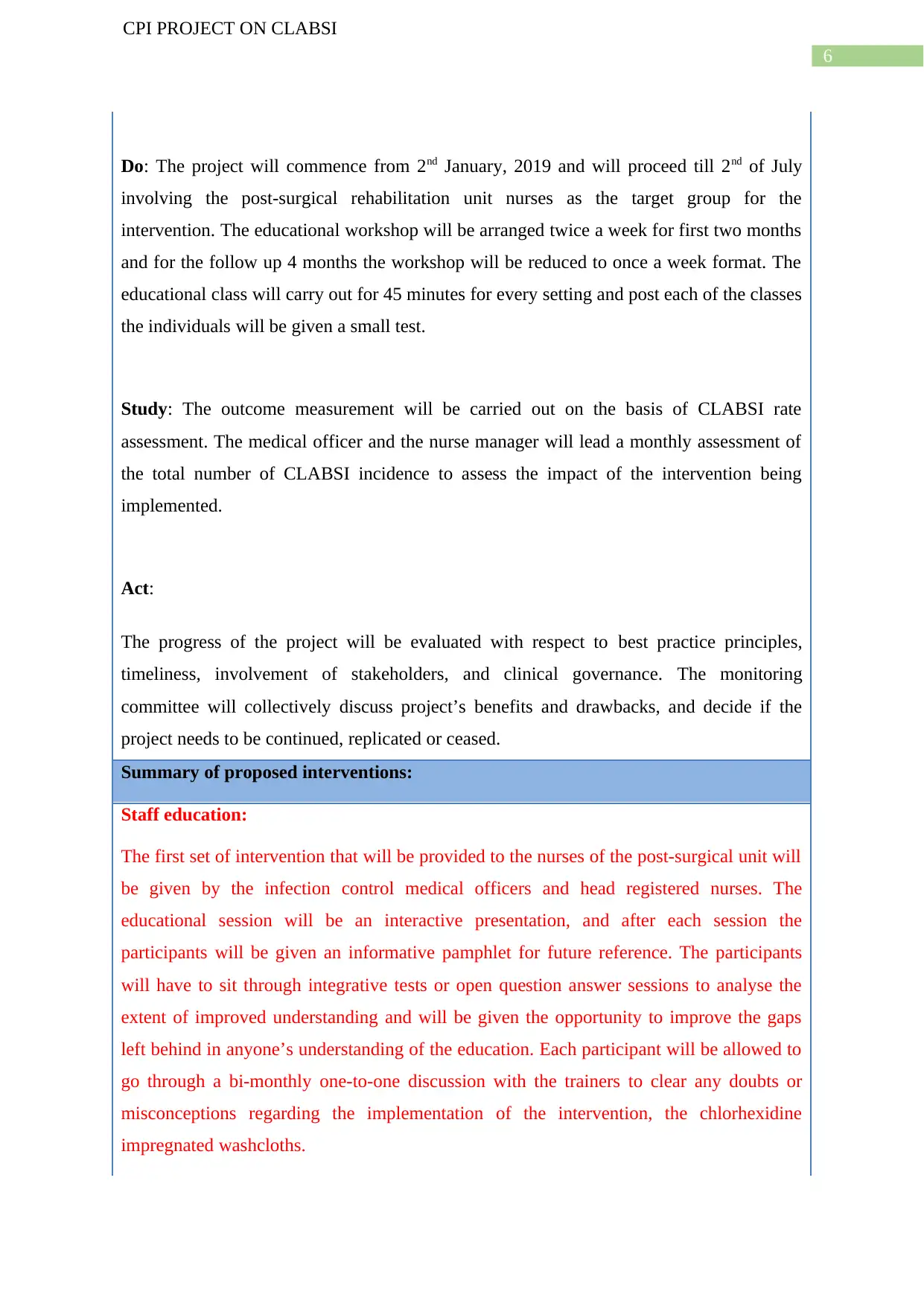
6
CPI PROJECT ON CLABSI
Do: The project will commence from 2nd January, 2019 and will proceed till 2nd of July
involving the post-surgical rehabilitation unit nurses as the target group for the
intervention. The educational workshop will be arranged twice a week for first two months
and for the follow up 4 months the workshop will be reduced to once a week format. The
educational class will carry out for 45 minutes for every setting and post each of the classes
the individuals will be given a small test.
Study: The outcome measurement will be carried out on the basis of CLABSI rate
assessment. The medical officer and the nurse manager will lead a monthly assessment of
the total number of CLABSI incidence to assess the impact of the intervention being
implemented.
Act:
The progress of the project will be evaluated with respect to best practice principles,
timeliness, involvement of stakeholders, and clinical governance. The monitoring
committee will collectively discuss project’s benefits and drawbacks, and decide if the
project needs to be continued, replicated or ceased.
Summary of proposed interventions:
Staff education:
The first set of intervention that will be provided to the nurses of the post-surgical unit will
be given by the infection control medical officers and head registered nurses. The
educational session will be an interactive presentation, and after each session the
participants will be given an informative pamphlet for future reference. The participants
will have to sit through integrative tests or open question answer sessions to analyse the
extent of improved understanding and will be given the opportunity to improve the gaps
left behind in anyone’s understanding of the education. Each participant will be allowed to
go through a bi-monthly one-to-one discussion with the trainers to clear any doubts or
misconceptions regarding the implementation of the intervention, the chlorhexidine
impregnated washcloths.
CPI PROJECT ON CLABSI
Do: The project will commence from 2nd January, 2019 and will proceed till 2nd of July
involving the post-surgical rehabilitation unit nurses as the target group for the
intervention. The educational workshop will be arranged twice a week for first two months
and for the follow up 4 months the workshop will be reduced to once a week format. The
educational class will carry out for 45 minutes for every setting and post each of the classes
the individuals will be given a small test.
Study: The outcome measurement will be carried out on the basis of CLABSI rate
assessment. The medical officer and the nurse manager will lead a monthly assessment of
the total number of CLABSI incidence to assess the impact of the intervention being
implemented.
Act:
The progress of the project will be evaluated with respect to best practice principles,
timeliness, involvement of stakeholders, and clinical governance. The monitoring
committee will collectively discuss project’s benefits and drawbacks, and decide if the
project needs to be continued, replicated or ceased.
Summary of proposed interventions:
Staff education:
The first set of intervention that will be provided to the nurses of the post-surgical unit will
be given by the infection control medical officers and head registered nurses. The
educational session will be an interactive presentation, and after each session the
participants will be given an informative pamphlet for future reference. The participants
will have to sit through integrative tests or open question answer sessions to analyse the
extent of improved understanding and will be given the opportunity to improve the gaps
left behind in anyone’s understanding of the education. Each participant will be allowed to
go through a bi-monthly one-to-one discussion with the trainers to clear any doubts or
misconceptions regarding the implementation of the intervention, the chlorhexidine
impregnated washcloths.
Paraphrase This Document
Need a fresh take? Get an instant paraphrase of this document with our AI Paraphraser
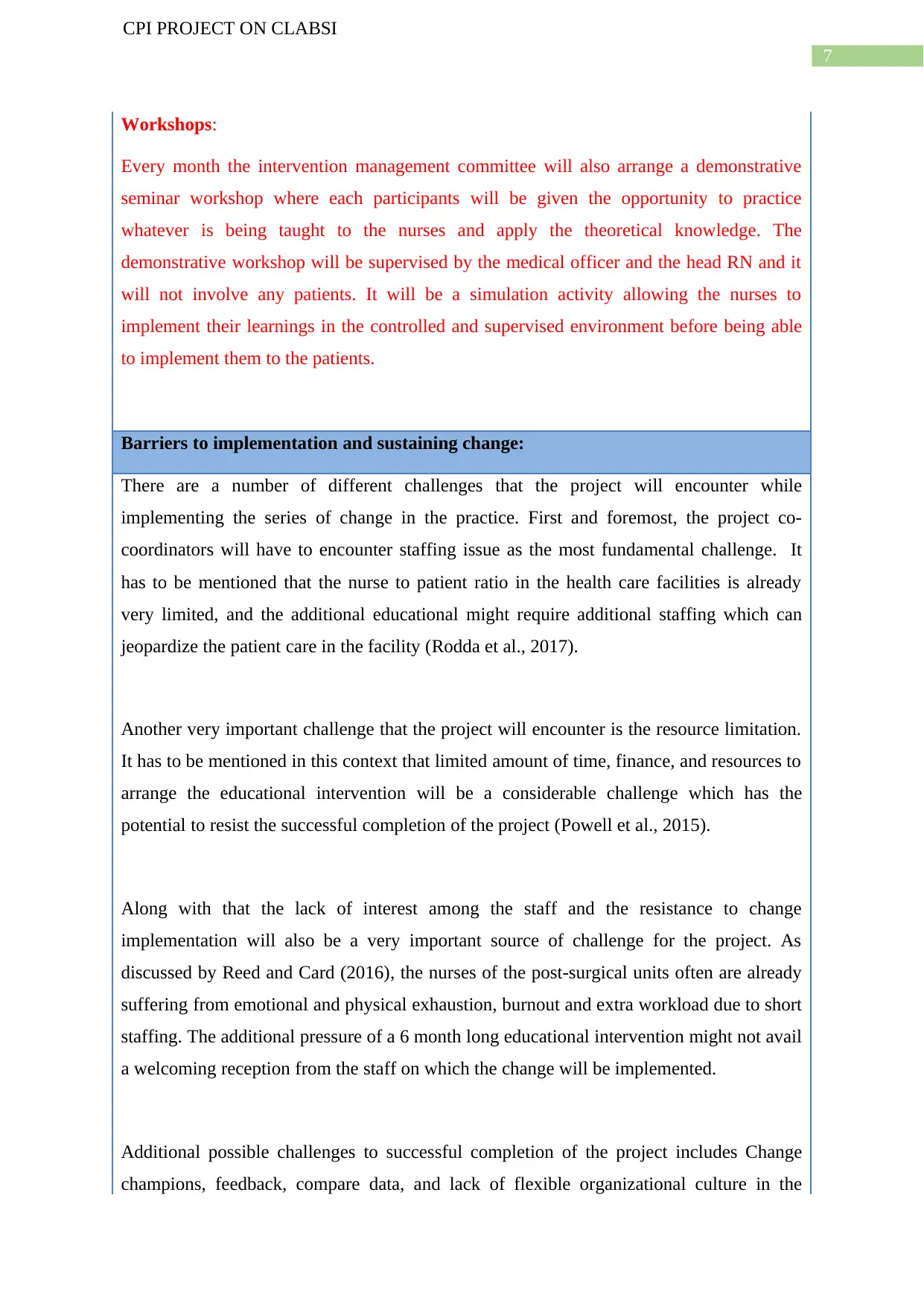
7
CPI PROJECT ON CLABSI
Workshops:
Every month the intervention management committee will also arrange a demonstrative
seminar workshop where each participants will be given the opportunity to practice
whatever is being taught to the nurses and apply the theoretical knowledge. The
demonstrative workshop will be supervised by the medical officer and the head RN and it
will not involve any patients. It will be a simulation activity allowing the nurses to
implement their learnings in the controlled and supervised environment before being able
to implement them to the patients.
Barriers to implementation and sustaining change:
There are a number of different challenges that the project will encounter while
implementing the series of change in the practice. First and foremost, the project co-
coordinators will have to encounter staffing issue as the most fundamental challenge. It
has to be mentioned that the nurse to patient ratio in the health care facilities is already
very limited, and the additional educational might require additional staffing which can
jeopardize the patient care in the facility (Rodda et al., 2017).
Another very important challenge that the project will encounter is the resource limitation.
It has to be mentioned in this context that limited amount of time, finance, and resources to
arrange the educational intervention will be a considerable challenge which has the
potential to resist the successful completion of the project (Powell et al., 2015).
Along with that the lack of interest among the staff and the resistance to change
implementation will also be a very important source of challenge for the project. As
discussed by Reed and Card (2016), the nurses of the post-surgical units often are already
suffering from emotional and physical exhaustion, burnout and extra workload due to short
staffing. The additional pressure of a 6 month long educational intervention might not avail
a welcoming reception from the staff on which the change will be implemented.
Additional possible challenges to successful completion of the project includes Change
champions, feedback, compare data, and lack of flexible organizational culture in the
CPI PROJECT ON CLABSI
Workshops:
Every month the intervention management committee will also arrange a demonstrative
seminar workshop where each participants will be given the opportunity to practice
whatever is being taught to the nurses and apply the theoretical knowledge. The
demonstrative workshop will be supervised by the medical officer and the head RN and it
will not involve any patients. It will be a simulation activity allowing the nurses to
implement their learnings in the controlled and supervised environment before being able
to implement them to the patients.
Barriers to implementation and sustaining change:
There are a number of different challenges that the project will encounter while
implementing the series of change in the practice. First and foremost, the project co-
coordinators will have to encounter staffing issue as the most fundamental challenge. It
has to be mentioned that the nurse to patient ratio in the health care facilities is already
very limited, and the additional educational might require additional staffing which can
jeopardize the patient care in the facility (Rodda et al., 2017).
Another very important challenge that the project will encounter is the resource limitation.
It has to be mentioned in this context that limited amount of time, finance, and resources to
arrange the educational intervention will be a considerable challenge which has the
potential to resist the successful completion of the project (Powell et al., 2015).
Along with that the lack of interest among the staff and the resistance to change
implementation will also be a very important source of challenge for the project. As
discussed by Reed and Card (2016), the nurses of the post-surgical units often are already
suffering from emotional and physical exhaustion, burnout and extra workload due to short
staffing. The additional pressure of a 6 month long educational intervention might not avail
a welcoming reception from the staff on which the change will be implemented.
Additional possible challenges to successful completion of the project includes Change
champions, feedback, compare data, and lack of flexible organizational culture in the
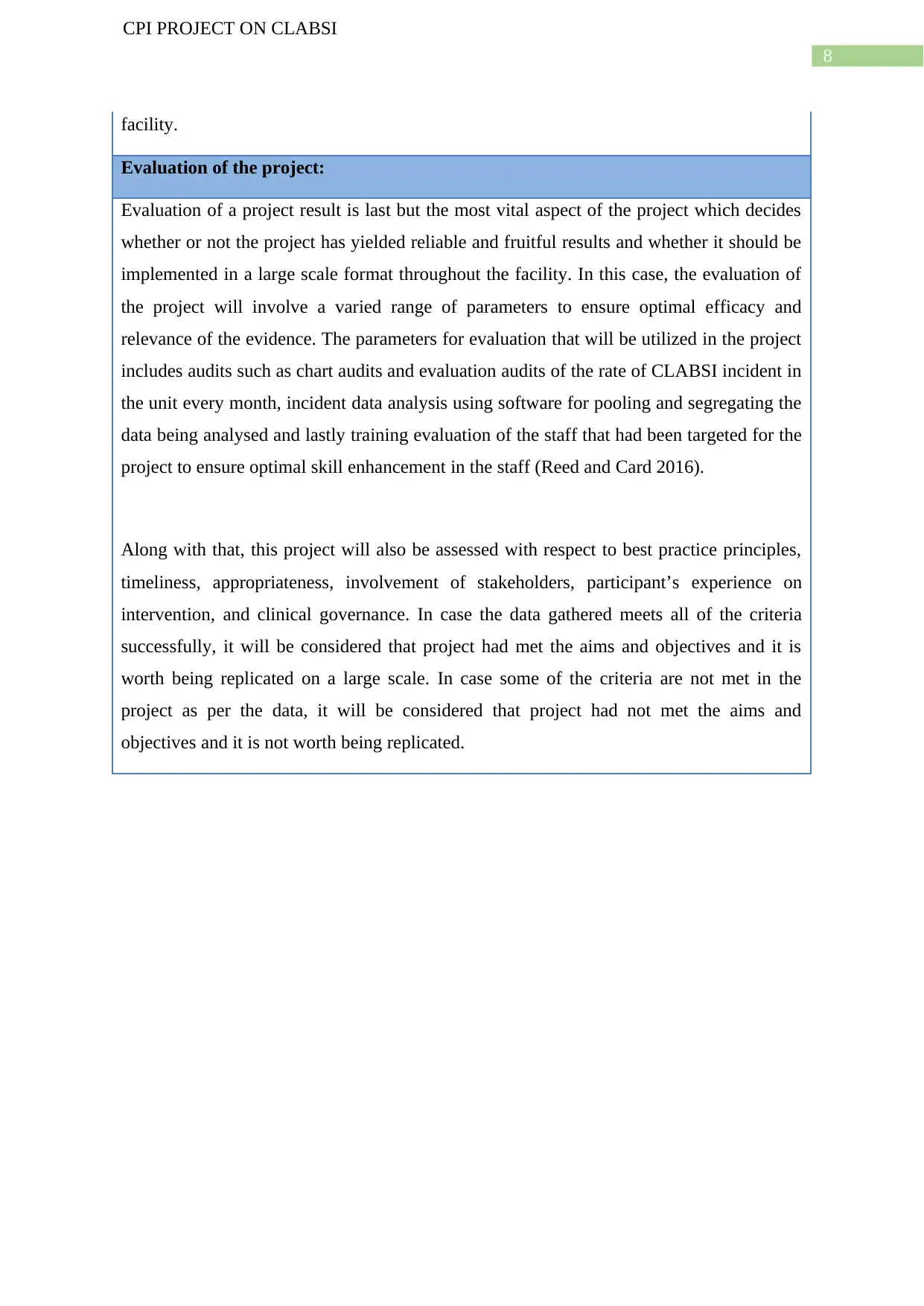
8
CPI PROJECT ON CLABSI
facility.
Evaluation of the project:
Evaluation of a project result is last but the most vital aspect of the project which decides
whether or not the project has yielded reliable and fruitful results and whether it should be
implemented in a large scale format throughout the facility. In this case, the evaluation of
the project will involve a varied range of parameters to ensure optimal efficacy and
relevance of the evidence. The parameters for evaluation that will be utilized in the project
includes audits such as chart audits and evaluation audits of the rate of CLABSI incident in
the unit every month, incident data analysis using software for pooling and segregating the
data being analysed and lastly training evaluation of the staff that had been targeted for the
project to ensure optimal skill enhancement in the staff (Reed and Card 2016).
Along with that, this project will also be assessed with respect to best practice principles,
timeliness, appropriateness, involvement of stakeholders, participant’s experience on
intervention, and clinical governance. In case the data gathered meets all of the criteria
successfully, it will be considered that project had met the aims and objectives and it is
worth being replicated on a large scale. In case some of the criteria are not met in the
project as per the data, it will be considered that project had not met the aims and
objectives and it is not worth being replicated.
CPI PROJECT ON CLABSI
facility.
Evaluation of the project:
Evaluation of a project result is last but the most vital aspect of the project which decides
whether or not the project has yielded reliable and fruitful results and whether it should be
implemented in a large scale format throughout the facility. In this case, the evaluation of
the project will involve a varied range of parameters to ensure optimal efficacy and
relevance of the evidence. The parameters for evaluation that will be utilized in the project
includes audits such as chart audits and evaluation audits of the rate of CLABSI incident in
the unit every month, incident data analysis using software for pooling and segregating the
data being analysed and lastly training evaluation of the staff that had been targeted for the
project to ensure optimal skill enhancement in the staff (Reed and Card 2016).
Along with that, this project will also be assessed with respect to best practice principles,
timeliness, appropriateness, involvement of stakeholders, participant’s experience on
intervention, and clinical governance. In case the data gathered meets all of the criteria
successfully, it will be considered that project had met the aims and objectives and it is
worth being replicated on a large scale. In case some of the criteria are not met in the
project as per the data, it will be considered that project had not met the aims and
objectives and it is not worth being replicated.
⊘ This is a preview!⊘
Do you want full access?
Subscribe today to unlock all pages.

Trusted by 1+ million students worldwide
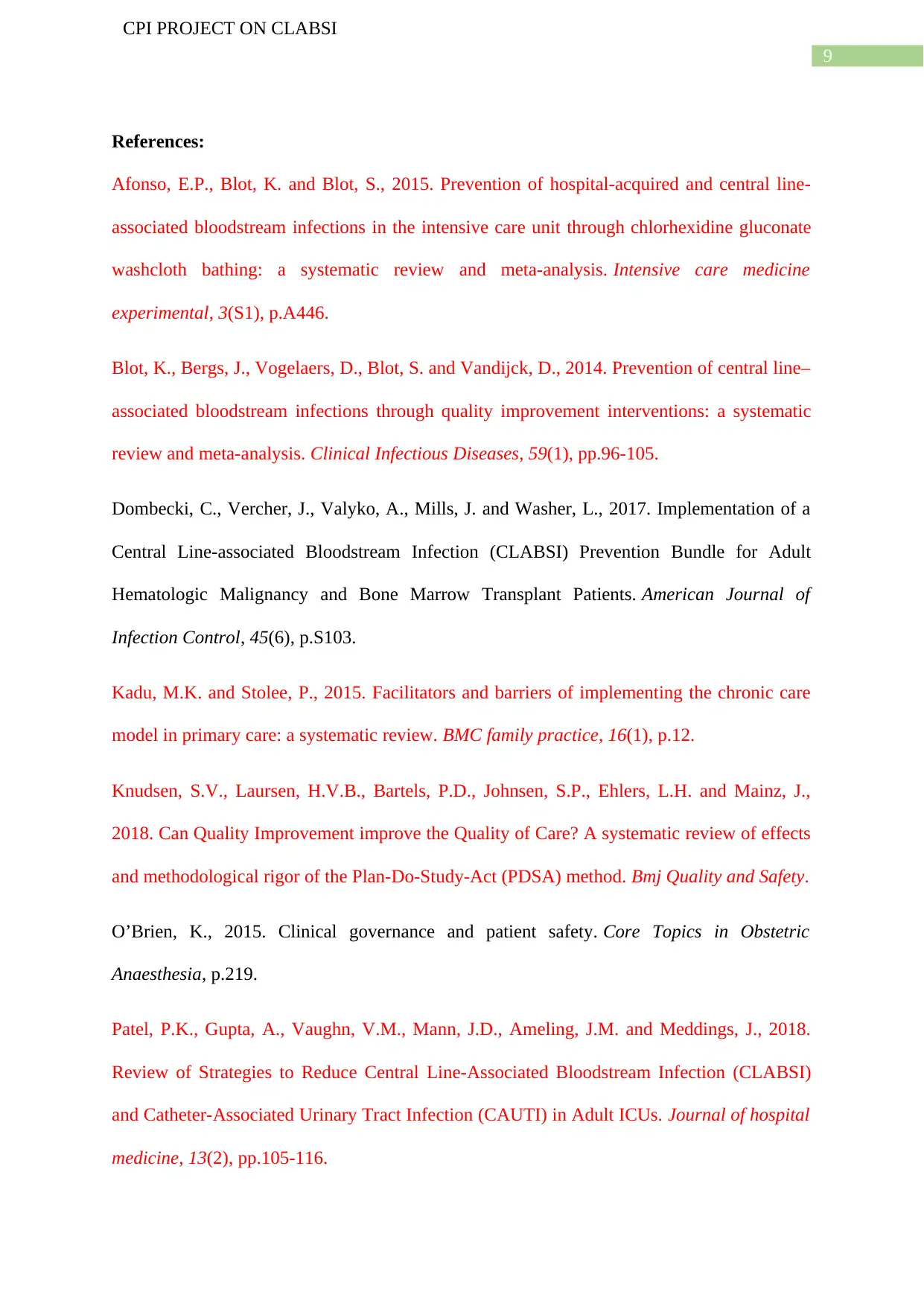
9
CPI PROJECT ON CLABSI
References:
Afonso, E.P., Blot, K. and Blot, S., 2015. Prevention of hospital-acquired and central line-
associated bloodstream infections in the intensive care unit through chlorhexidine gluconate
washcloth bathing: a systematic review and meta-analysis. Intensive care medicine
experimental, 3(S1), p.A446.
Blot, K., Bergs, J., Vogelaers, D., Blot, S. and Vandijck, D., 2014. Prevention of central line–
associated bloodstream infections through quality improvement interventions: a systematic
review and meta-analysis. Clinical Infectious Diseases, 59(1), pp.96-105.
Dombecki, C., Vercher, J., Valyko, A., Mills, J. and Washer, L., 2017. Implementation of a
Central Line-associated Bloodstream Infection (CLABSI) Prevention Bundle for Adult
Hematologic Malignancy and Bone Marrow Transplant Patients. American Journal of
Infection Control, 45(6), p.S103.
Kadu, M.K. and Stolee, P., 2015. Facilitators and barriers of implementing the chronic care
model in primary care: a systematic review. BMC family practice, 16(1), p.12.
Knudsen, S.V., Laursen, H.V.B., Bartels, P.D., Johnsen, S.P., Ehlers, L.H. and Mainz, J.,
2018. Can Quality Improvement improve the Quality of Care? A systematic review of effects
and methodological rigor of the Plan-Do-Study-Act (PDSA) method. Bmj Quality and Safety.
O’Brien, K., 2015. Clinical governance and patient safety. Core Topics in Obstetric
Anaesthesia, p.219.
Patel, P.K., Gupta, A., Vaughn, V.M., Mann, J.D., Ameling, J.M. and Meddings, J., 2018.
Review of Strategies to Reduce Central Line-Associated Bloodstream Infection (CLABSI)
and Catheter-Associated Urinary Tract Infection (CAUTI) in Adult ICUs. Journal of hospital
medicine, 13(2), pp.105-116.
CPI PROJECT ON CLABSI
References:
Afonso, E.P., Blot, K. and Blot, S., 2015. Prevention of hospital-acquired and central line-
associated bloodstream infections in the intensive care unit through chlorhexidine gluconate
washcloth bathing: a systematic review and meta-analysis. Intensive care medicine
experimental, 3(S1), p.A446.
Blot, K., Bergs, J., Vogelaers, D., Blot, S. and Vandijck, D., 2014. Prevention of central line–
associated bloodstream infections through quality improvement interventions: a systematic
review and meta-analysis. Clinical Infectious Diseases, 59(1), pp.96-105.
Dombecki, C., Vercher, J., Valyko, A., Mills, J. and Washer, L., 2017. Implementation of a
Central Line-associated Bloodstream Infection (CLABSI) Prevention Bundle for Adult
Hematologic Malignancy and Bone Marrow Transplant Patients. American Journal of
Infection Control, 45(6), p.S103.
Kadu, M.K. and Stolee, P., 2015. Facilitators and barriers of implementing the chronic care
model in primary care: a systematic review. BMC family practice, 16(1), p.12.
Knudsen, S.V., Laursen, H.V.B., Bartels, P.D., Johnsen, S.P., Ehlers, L.H. and Mainz, J.,
2018. Can Quality Improvement improve the Quality of Care? A systematic review of effects
and methodological rigor of the Plan-Do-Study-Act (PDSA) method. Bmj Quality and Safety.
O’Brien, K., 2015. Clinical governance and patient safety. Core Topics in Obstetric
Anaesthesia, p.219.
Patel, P.K., Gupta, A., Vaughn, V.M., Mann, J.D., Ameling, J.M. and Meddings, J., 2018.
Review of Strategies to Reduce Central Line-Associated Bloodstream Infection (CLABSI)
and Catheter-Associated Urinary Tract Infection (CAUTI) in Adult ICUs. Journal of hospital
medicine, 13(2), pp.105-116.
Paraphrase This Document
Need a fresh take? Get an instant paraphrase of this document with our AI Paraphraser
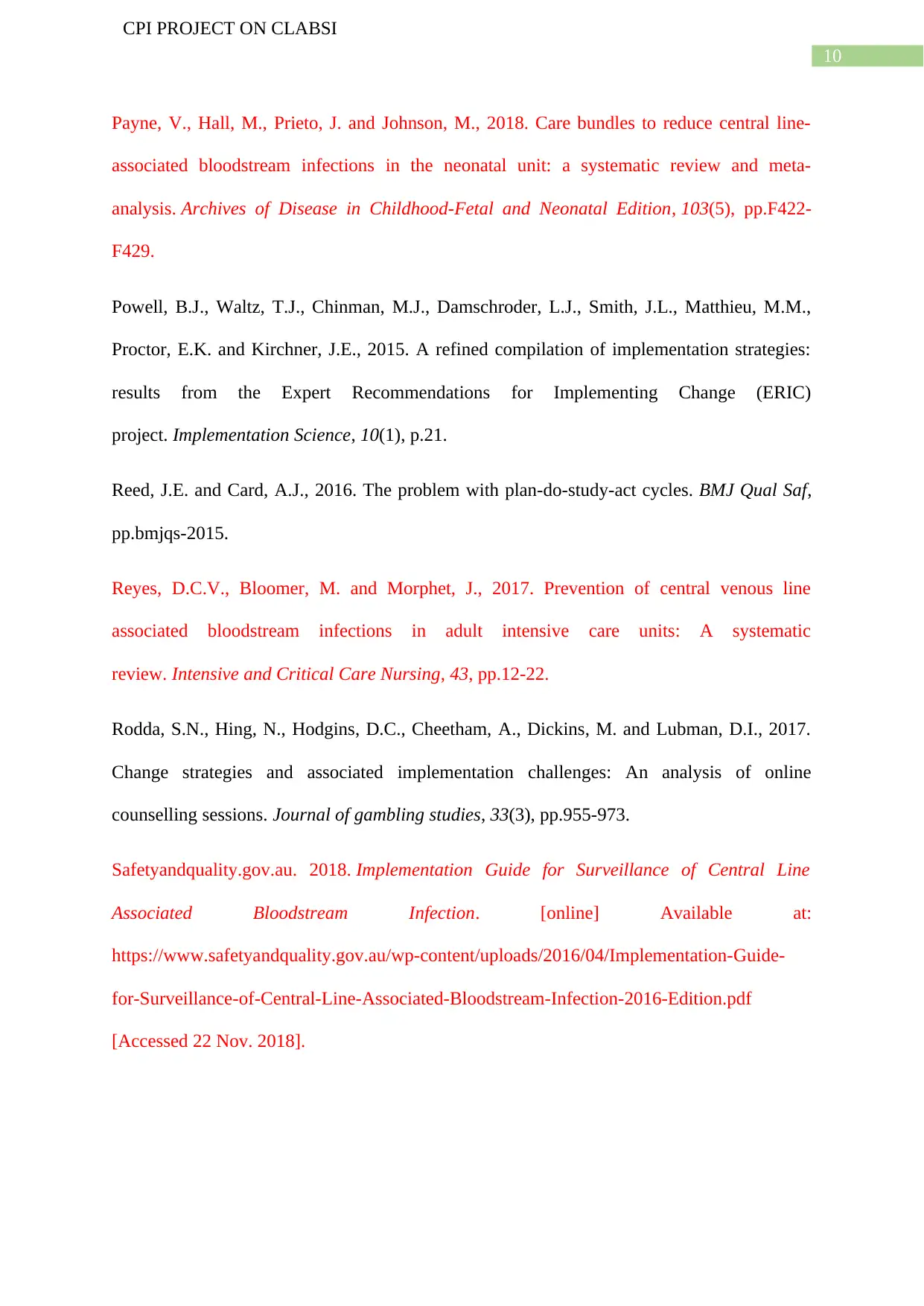
10
CPI PROJECT ON CLABSI
Payne, V., Hall, M., Prieto, J. and Johnson, M., 2018. Care bundles to reduce central line-
associated bloodstream infections in the neonatal unit: a systematic review and meta-
analysis. Archives of Disease in Childhood-Fetal and Neonatal Edition, 103(5), pp.F422-
F429.
Powell, B.J., Waltz, T.J., Chinman, M.J., Damschroder, L.J., Smith, J.L., Matthieu, M.M.,
Proctor, E.K. and Kirchner, J.E., 2015. A refined compilation of implementation strategies:
results from the Expert Recommendations for Implementing Change (ERIC)
project. Implementation Science, 10(1), p.21.
Reed, J.E. and Card, A.J., 2016. The problem with plan-do-study-act cycles. BMJ Qual Saf,
pp.bmjqs-2015.
Reyes, D.C.V., Bloomer, M. and Morphet, J., 2017. Prevention of central venous line
associated bloodstream infections in adult intensive care units: A systematic
review. Intensive and Critical Care Nursing, 43, pp.12-22.
Rodda, S.N., Hing, N., Hodgins, D.C., Cheetham, A., Dickins, M. and Lubman, D.I., 2017.
Change strategies and associated implementation challenges: An analysis of online
counselling sessions. Journal of gambling studies, 33(3), pp.955-973.
Safetyandquality.gov.au. 2018. Implementation Guide for Surveillance of Central Line
Associated Bloodstream Infection. [online] Available at:
https://www.safetyandquality.gov.au/wp-content/uploads/2016/04/Implementation-Guide-
for-Surveillance-of-Central-Line-Associated-Bloodstream-Infection-2016-Edition.pdf
[Accessed 22 Nov. 2018].
CPI PROJECT ON CLABSI
Payne, V., Hall, M., Prieto, J. and Johnson, M., 2018. Care bundles to reduce central line-
associated bloodstream infections in the neonatal unit: a systematic review and meta-
analysis. Archives of Disease in Childhood-Fetal and Neonatal Edition, 103(5), pp.F422-
F429.
Powell, B.J., Waltz, T.J., Chinman, M.J., Damschroder, L.J., Smith, J.L., Matthieu, M.M.,
Proctor, E.K. and Kirchner, J.E., 2015. A refined compilation of implementation strategies:
results from the Expert Recommendations for Implementing Change (ERIC)
project. Implementation Science, 10(1), p.21.
Reed, J.E. and Card, A.J., 2016. The problem with plan-do-study-act cycles. BMJ Qual Saf,
pp.bmjqs-2015.
Reyes, D.C.V., Bloomer, M. and Morphet, J., 2017. Prevention of central venous line
associated bloodstream infections in adult intensive care units: A systematic
review. Intensive and Critical Care Nursing, 43, pp.12-22.
Rodda, S.N., Hing, N., Hodgins, D.C., Cheetham, A., Dickins, M. and Lubman, D.I., 2017.
Change strategies and associated implementation challenges: An analysis of online
counselling sessions. Journal of gambling studies, 33(3), pp.955-973.
Safetyandquality.gov.au. 2018. Implementation Guide for Surveillance of Central Line
Associated Bloodstream Infection. [online] Available at:
https://www.safetyandquality.gov.au/wp-content/uploads/2016/04/Implementation-Guide-
for-Surveillance-of-Central-Line-Associated-Bloodstream-Infection-2016-Edition.pdf
[Accessed 22 Nov. 2018].
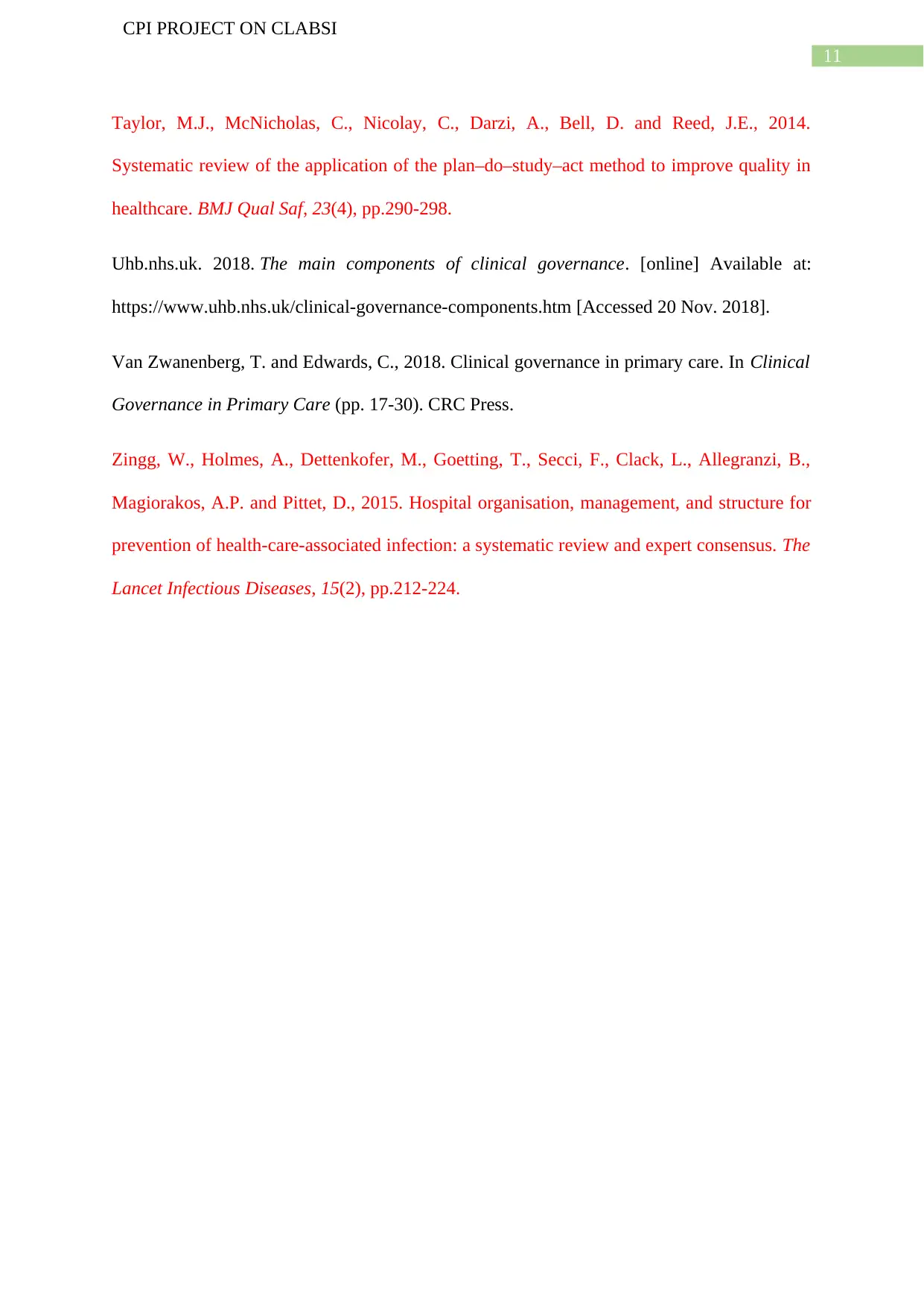
11
CPI PROJECT ON CLABSI
Taylor, M.J., McNicholas, C., Nicolay, C., Darzi, A., Bell, D. and Reed, J.E., 2014.
Systematic review of the application of the plan–do–study–act method to improve quality in
healthcare. BMJ Qual Saf, 23(4), pp.290-298.
Uhb.nhs.uk. 2018. The main components of clinical governance. [online] Available at:
https://www.uhb.nhs.uk/clinical-governance-components.htm [Accessed 20 Nov. 2018].
Van Zwanenberg, T. and Edwards, C., 2018. Clinical governance in primary care. In Clinical
Governance in Primary Care (pp. 17-30). CRC Press.
Zingg, W., Holmes, A., Dettenkofer, M., Goetting, T., Secci, F., Clack, L., Allegranzi, B.,
Magiorakos, A.P. and Pittet, D., 2015. Hospital organisation, management, and structure for
prevention of health-care-associated infection: a systematic review and expert consensus. The
Lancet Infectious Diseases, 15(2), pp.212-224.
CPI PROJECT ON CLABSI
Taylor, M.J., McNicholas, C., Nicolay, C., Darzi, A., Bell, D. and Reed, J.E., 2014.
Systematic review of the application of the plan–do–study–act method to improve quality in
healthcare. BMJ Qual Saf, 23(4), pp.290-298.
Uhb.nhs.uk. 2018. The main components of clinical governance. [online] Available at:
https://www.uhb.nhs.uk/clinical-governance-components.htm [Accessed 20 Nov. 2018].
Van Zwanenberg, T. and Edwards, C., 2018. Clinical governance in primary care. In Clinical
Governance in Primary Care (pp. 17-30). CRC Press.
Zingg, W., Holmes, A., Dettenkofer, M., Goetting, T., Secci, F., Clack, L., Allegranzi, B.,
Magiorakos, A.P. and Pittet, D., 2015. Hospital organisation, management, and structure for
prevention of health-care-associated infection: a systematic review and expert consensus. The
Lancet Infectious Diseases, 15(2), pp.212-224.
⊘ This is a preview!⊘
Do you want full access?
Subscribe today to unlock all pages.

Trusted by 1+ million students worldwide
1 out of 12
Related Documents
Your All-in-One AI-Powered Toolkit for Academic Success.
+13062052269
info@desklib.com
Available 24*7 on WhatsApp / Email
![[object Object]](/_next/static/media/star-bottom.7253800d.svg)
Unlock your academic potential
Copyright © 2020–2025 A2Z Services. All Rights Reserved. Developed and managed by ZUCOL.





